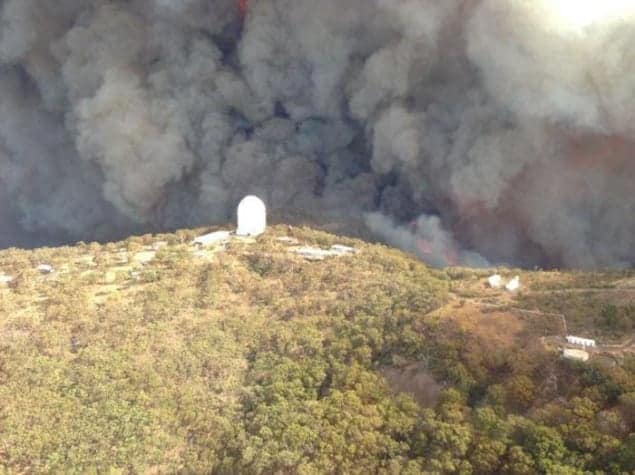
A large bushfire has swept across Australia’s largest optical and infrared observatory, closing it at least until the end of January. Preliminary assessments of the Siding Spring Observatory, located around 500 km north-west of Sydney, indicate that precautionary measures saved the telescopes from major damage but that three buildings belonging to the observatory have been destroyed with a further three badly damaged.
Siding Spring is operated by the Australian National University (ANU) and is home to 11 telescopes including the 4 m Anglo-Australian Telescope, which is run by the Australian Astronomical Observatory (AAO). The 420 km2 bushfire started on 13 January in the surrounding Warrumbungle National Park after several days of high temperatures and a series of lightning strikes.
Staff were quickly evacuated hours before the blaze swept across the site – almost 10 years to the day that bushfires destroyed much of ANU’s Mount Stromlo Observatory in Canberra. The Siding Spring telescopes were saved largely thanks to several precautionary measures that were implemented at the observatory after the experience at Mount Stromlo. These include the burning of vegetation surrounding the site at Siding Spring, the installation of mesh screens on the building’s windows, doors and vents as well as the use of heat retardant paint.
‘Still in shock’
Early inspections, carried out over the last three days by staff from the AAO and ANU, suggest the measures were successful in protecting the instrumentation. An initial inspection of the Anglo-Australian Telescope and the 1.2 m UK Schmidt Telescope found ash and debris inside the domes, but no visible damage to any of the instruments. Inspections of other telescopes were also promising, revealing only smoke damage and small amounts of ash inside the telescope’s housing.
However, three buildings, including the staff-accommodation lodge, have been completely destroyed and a further three have been badly damaged, including the visitors’ centre. The fire has also knocked out electricity and water supplies to the site and has closed the road accessing the observatory, with urgent work being undertaken to restore power and water to the site. Nearby, several homes of observatory staff have also been destroyed.
Detailed inspections and testing will start on Monday, to assess the full extent of any damage to instrumentation as well as a clean-up of the site to make it safe for staff to return. Those tests will last several weeks and a date for the reopening of the observatory is currently unknown.
Speaking to physicsworld.com, AAO astronomer Amanda Bauer, who is based in Sydney, says staff are still in shock, but on the whole relieved by initial reports from the site. “We hope to get the telescopes operational as soon as possible,” she says. “Those of us who have observations scheduled during the coming months are still making arrangements as we normally would, until we hear otherwise.”



